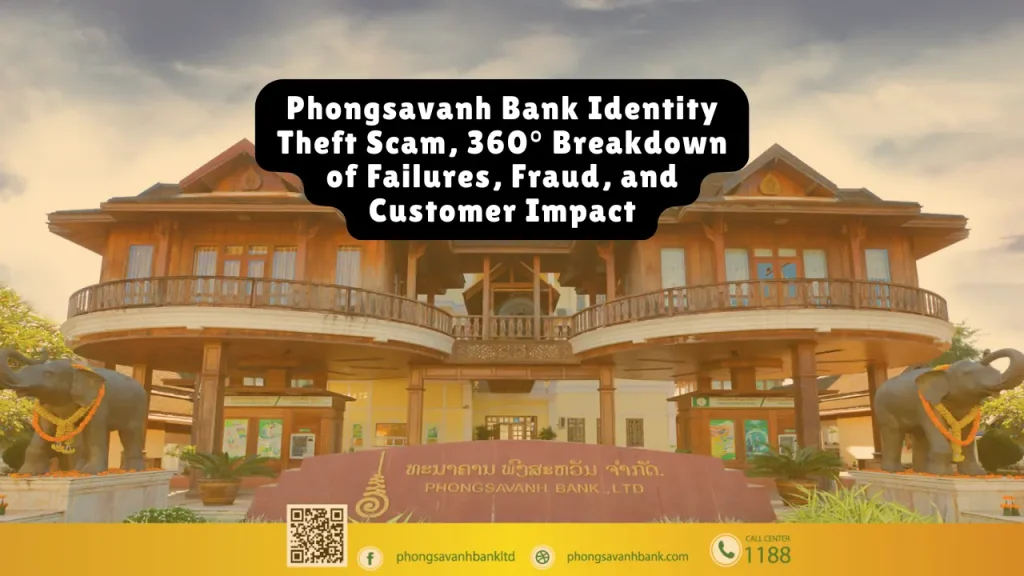Phongsavanh Bank Identity Theft Scam, 360° Breakdown of Failures, Fraud, and Customer Impact
Phongsavanh Bank Ltd—a financial institution based in Laos—has recently drawn intense scrutiny following a surge in identity theft cases tied to its operations. Despite its digital modernization and cross-border partnerships, the bank has become a hotspot for cyber-enabled fraud, exposing systemic weaknesses in cybersecurity, compliance, and consumer protection. This in-depth report merges victim stories, scam mechanics, institutional flaws, and legal recourse to equip both individuals and businesses with the tools to understand and defend against similar threats.
Table of Contents
Background: A High-Risk Institution Operating in Regulatory Shadows
Phongsavanh Bank has long been classified as a high-risk entity. A 2025 WikiFX review branded the bank as “suspicious” due to its questionable licensing status and lack of transparent oversight. Several red flags have emerged:
- Non-compliance with AML/KYC Protocols: The bank’s lax approach to anti-money laundering (AML) and know-your-customer (KYC) standards enabled fraudulent transactions to flow unchecked.
- Third-Party Exploits: Legitimate partnerships—such as with JP Morgan Chase for USD remittances—were weaponized by scammers to facilitate the movement of stolen funds.
- Cybersecurity Failures: Outdated encryption methods, weak authentication protocols, and insufficient access controls left customer data wide open to exploitation.
Anatomy of the Scam: How Phongsavanh Customers Were Targeted
1. Phishing, SMiShing, and Vishing Campaigns
Scammers launched widespread attacks using fake SMS alerts (“SMiShing”), spoofed voice calls (“Vishing”), and cloned email links to net-banking portals. Victims were tricked into surrendering OTPs, IPINs, Customer IDs, and even CVVs. For example:
- SMiShing Message:
“Your Phongsavanh account will be locked. Reply with OTP to avoid suspension.”
A Vientiane customer lost USD 350 within minutes after replying to such a message, sent from a fake ID labeled “PHONGBNK.” - Vishing Call:
“This is the Fraud Dept. of Phongsavanh Bank. Confirm your CVV and PIN to prevent account deactivation.”
One Champasak victim lost over USD 1,200 overnight. - Fake App Installations:
Victims received emails prompting them to update the “Hi App,” leading to the installation of malware that siphoned login sessions and rerouted funds internationally.
2. SIM Swap Fraud
By bribing telecom employees, fraudsters hijacked victims’ phone numbers and intercepted SMS-based OTPs. This allowed them to bypass basic login protections and steal funds, all while fraud alerts from the bank arrived too late—often days or even weeks after the transactions.
3. AI-Driven Social Engineering
Some attacks utilized AI-generated voice clones posing as bank officials, further convincing customers to provide sensitive information. The bank’s lack of multi-factor authentication (MFA) made these tactics even more successful.
Related article for you:
Dumpster Diving Identity Theft Statistics,

A Victim’s Story: Bureaucracy and Blame
In one 2024 case, a small business owner in Laos lost USD 15,000 after a fraudster—armed with accurate transaction history—posed as a bank employee. Despite filing a police report and contacting the bank, he was met with delays and blame-shifting. The bank cited “user negligence” and refused reimbursement.
Institutional and Legal Failures
1. No Clear Path to Legal Recourse
Laos lacks comprehensive consumer protection comparable to U.S. laws like the 2024 Protecting Consumers from Payment Scams Act, leaving most victims without compensation or legal clarity.
However, some relevant legislation exists:
- Cybercrime Prevention and Security Act (2015): Criminalizes unauthorized access and data theft.
- Consumer Protection Decree (2020): Requires banks to notify customers and regulators of data breaches within 72 hours.
- Civil Code – Tort and Damage Compensation Articles: Allows victims to sue for financial losses—but court procedures are complex and poorly publicized.
2. Inconsistent Fraud Monitoring
Phongsavanh’s internal systems failed to flag anomalies such as sudden international transfers or rapid withdrawals. Delayed fraud alerts further compounded customer losses.
3. Poor Data Governance
Internal audits revealed unencrypted customer data stored on outdated servers. Employees with minimal clearance could access sensitive information—making insider leaks both possible and probable.
Reality Check: What the Bank Advises vs. What Customers Experience
Official Guidelines from Phongsavanh Bank:
- Shred documents with personal details.
- Never share PINs, OTPs, or CVVs.
- Keep contact details updated.
Reality:
- No sample scam scripts are offered.
- No defined workflows for recovery.
- No direct links to regulatory agencies or legal complaint portals.
What to Do If You’re a Victim: Step-by-Step Guide
Immediate Actions:
- Freeze Your Account: Call Phongsavanh’s hotline (Inside Laos: 1188 | International: +856 21 716 999) to block outgoing transfers.
- Request Transaction Logs: Obtain detailed records of all recent activity.
- Report the Incident:
- Lao FIU or Police: File a complaint with the Financial Intelligence Unit and local police; keep the case number.
- Bank of Lao P.D.R. Consumer Portal: https://www.bol.gov.la/en/index
- Lao FIU or Police: File a complaint with the Financial Intelligence Unit and local police; keep the case number.
- Monitor Your Credit: Use Experian or other agencies to check for loans or cards opened in your name.
- Switch to App-Based MFA: Avoid SMS-based verification for all banking activities.
For Businesses and NGOs: Strengthen Your Cyber Defenses
Essential Safeguards:
- Employee Training: Host quarterly workshops on phishing, vishing, and SMiShing.
- Secure Document Destruction: Partner with certified shredding vendors and verify destruction certificates.
- Dumpster Security: Install lockable waste bins and conduct random waste audits.
- Access Controls: Implement role-based permissions and monitor all PII access events.
Broader Implications: A Call for Reform and Global Vigilance
The Phongsavanh Bank scandal is emblematic of a growing trend: unregulated or under-regulated institutions becoming breeding grounds for financial crime. Without coordinated international oversight and robust cybersecurity laws, more consumers—especially in developing markets—will fall victim.
Regulatory Arbitrage: Scammers exploit weak regional laws by targeting institutions like Phongsavanh that operate without full compliance.
Consumer Awareness: Ironically, the bank’s own advisory materials warn against scams it failed to prevent—highlighting the need for genuine, transparent consumer education.
Conclusion: Lessons and a Way Forward
The Phongsavanh Bank identity theft crisis underscores the critical need for regulatory reform, stronger cybersecurity frameworks, and real-world consumer protection. Victims, often blamed and abandoned, deserve clearer pathways to justice and reimbursement.
For Consumers:
- Never trust unsolicited requests for credentials.
- Report fraud immediately and keep all documentation.
- Demand institutions that prioritize compliance, security, and transparency.
For Regulators:
- Enforce mandatory breach notifications.
- Establish accessible legal recourse for consumers.
- Mandate robust fraud monitoring tools for all licensed banks.
By combining legal remedies, technical defenses, and institutional accountability, both individuals and businesses in Laos—and across Southeast Asia—can better protect themselves from the growing threat of financial identity theft.
Resources:
About the Author

Sarah Klein, JD, is a former consumer rights attorney who spent years helping clients with issues like unfair billing, product disputes, and debt collection practices. At All About Lawyer, she simplifies consumer protection laws so readers can defend their rights and resolve problems with confidence.
Read more about Sarah
